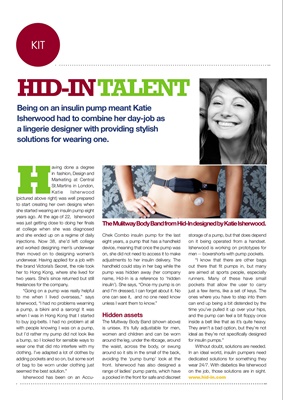
KIT
Being on an insulin pump meant Katie
Isherwood had to combine her day-job as
a lingerie designer with providing stylish
solutions for wearing one.
HID-IN TALENT
H
aving done a degree
in fashion, Design and
Marketing at Central
st.martins in London,
Katie Isherwood
(pictured above right) was well prepared
to start creating her own designs when
she started wearing an insulin pump eight
years ago. At the age of 22, Isherwood
was just getting close to doing her finals
at college when she was diagnosed
and she ended up on a regime of daily
injections. Now 38, she'd left college
and worked designing men's underwear
then moved on to designing women's
underwear. Having applied for a job with
the brand Victoria's Secret, the role took
her to Hong Kong, where she lived for
two years. She's since returned but still
freelances for the company.
"Going on a pump was really helpful
to me when I lived overseas," says
Isherwood, "I had no problems wearning
a pump, a bikini and a sarong! It was
when I was in Hong Kong that I started
to buy jog-belts. I had no problem at all
with people knowing I was on a pump,
but I'd rather my pump did not look like
a bump, so I looked for sensible ways to
wear one that did nto interfere with my
clothing. I've adapted a lot of clothes by
adding pockets and so on, but some sor
tof bag to be worn under clothing just
seemed the best solution."
Isherwood has been on an AccuThe Mulitway Body Band from
Hid-In designed by Katie Isherwood.
Chek Combo insulin pump for the last
eight years, a pump that has a handheld
device, meaning that once the pump was
on, she did not need to access it to make
adjustments to her insulin delivery. The
handheld could stay in her bag while the
pump was hidden away (her company
name, Hid-In is a reference to 'hidden
insulin'). She says, "Once my pump is on
and I"m dressed, I can forget about it. No
one can see it, and no one need know
unless I want them to know."
Hidden assets
The Multiway Body Band (shown above)
is unisex. It's fully adjustable for men,
women and children and can be worn
around the leg, under the ribcage, around
the waist, across the body, or swung
around so it sits in the small of the back,
avoiding the 'pump bump' look at the
front. Isherwood has also designed a
range of ladies' pump pants, which have
a pocked in the front for safe and discreet
storage of a pump, but that does depend
on it being operated from a handset.
Isherwood is working on prototypes for
men -- boxershorts with pump pockets.
"I know that there are other bags
out there that fit pumps in, but many
are aimed at sports people, especially
runners. Many of these have small
pockets that allow the user to carry
just a few items, like a set of keys. The
ones where you have to step into them
can end up being a bit distended by the
time you've pulled it up over your hips,
and the pump can feel a bit floppy once
inside a belt like that as it's quite heavy.
They aren't a bad option, but they're not
ideal as they're not specifically designed
for insulin pumps."
Without doubt, solutions are needed.
In an ideal world, insulin pumpers need
dedicated solutions for something they
wear 24/7. With diabetics like Isherwood
on the job, those solutions are in sight.
www.hid-in.com